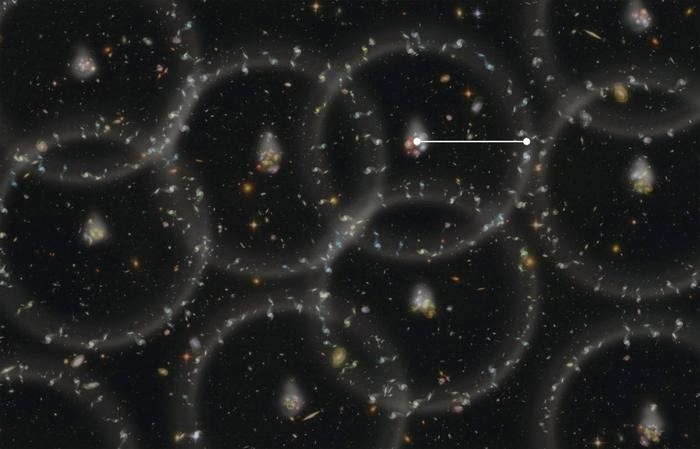A research group composed of individuals from Chinese universities and the University of Cordoba conducted a complicated statistical analysis of around one million galaxies. Their results were published in the journal Nature Astronomy.
 Recreation of Baryon Acoustic Oscillations. Image Credit: Recreation of Baryon Acoustic Oscillations. (Zosia Rostomian, Lawrence Berkeley National Laboratory).
Recreation of Baryon Acoustic Oscillations. Image Credit: Recreation of Baryon Acoustic Oscillations. (Zosia Rostomian, Lawrence Berkeley National Laboratory).
The group had been working on the project for more than two years, in hopes of making the identification of cosmological distances feasible with a new and greater degree of precision.
A new method was developed to detect what are known as Baryon Acoustic Oscillations (BAO). Such waves, whose existence was first illustrated in 2005, are one of the few traces of the Big Bang that could still be detected in the cosmos.
They spread at the time of the first 380,000 years of the universe’s life, extending like sound waves via matter so hot that it behaved like a fluid, something similar to what takes place when a stone is thrown into a pond. Consequently, the universe cooled and expanded to the point that those waves were frozen in time.
The fascinating thing about such oscillations, witnesses to nearly the complete history of the cosmos, is that their exact duration is known (500 million light-years), so they are now very beneficial for quantifying cosmological distances depending on the separation between galaxies.
Having the potential to detect them and identify their size is, thus, of the utmost significance to properly map the universe out to very distant points.
The results of this study now allow us to detect these waves through a new and independent method. By combining the two, we can determine cosmic distances with greater precision.
Antonio J. Cuesta, Study Sole Spanish Author and Researcher Department of Physics, University of Cordoba
The New Method: Looking for Anomalies in the Orientation of Galaxies
This new study examined, utilizing statistical methods, a database of around one million galaxies, thereby paying special attention to two very various factors: the ellipticity of the galaxies and the density around them.
Relating to their orientations, galaxies generally stretch to where there are a higher number of other galaxies, as a result of the pull of gravity, but there are some places in the universe where this effect is not as intense.
It is in those points, where galaxies do not point where they should, where statistics tell us that the Baryon Acoustic Oscillations are located, since these waves also act as points of gravity attraction.
Antonio J. Cuesta, Study Sole Spanish Author and Researcher Department of Physics, University of Cordoba
Looking Out Far, Looking Into the Past
The first practical application that this study could have is to establish more precisely where the galaxies are located, and the separation between them and the Earth, but, in a way, we are also gazing into the past.
Antonio J. Cuesta, Study Sole Spanish Author and Researcher Department of Physics, University of Cordoba
This new approach to Baryon Acoustic Oscillations, the key to answering a few of the great questions regarding the universe, sets the stage for the world of Astronomy.
Fixing cosmological distances provides, in return, new clues regarding the history of the universe’s expansion and helps one to comprehend its composition regarding dark matter and energy, two of the most enigmatic and elusive components of the cosmos.
Journal Reference:
Xu, K., et al. (2023) Evidence for baryon acoustic oscillations from galaxy–ellipticity correlations. Nature Astronomy. doi.org/10.1038/s41550-023-02035-4.